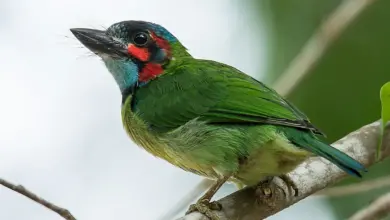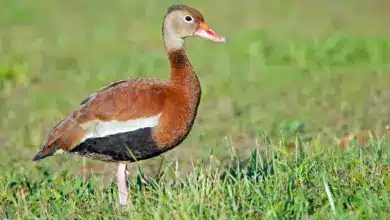The Antillean Nighthawks (Chordeiles gundlachii) – also known as Cuban Nightjar – occur naturally in South Florida through the West Indies.
This species was previously considered a subspecies of the very similar Common Nighthawk, Chordeiles minor. However, they are now considered separate species.

Alternate (Global) Names
Czech: Lelek Gundlachuv, lelek Gundlach?v … Danish: Caribernathøg … Dutch: Antilliaanse Nachtzwaluw … German: Antillen Nachtschwalbe, Antillennachtschwalbe, Antillennactschwalbe … Estonian: antilli videvikusorr … Finnish: Antillienhaukkakehrääjä … French: Engoulevent de Gundlach, Engoulevent piramidig … Italian: Caprimulgo-sparviero delle Antille, Succiacapre delle Antille … Japanese: karibuyotaka … Norwegian: Antillnatthauk … Polish: lelczyk antylski … Russian: ?????? ?????? … Slovak: súmracník antilský … Spanish: Añapero Antillano, Añapero Querequeté, Chotacabras Antillano, Pucuyo antillano, Querebebé, Querequequé, Querequeté … Swedish: Karibisk falknattskärra
Distribution / Range
The summer (breeding range) of the Antillean Nighthawk includes southern Florida (mostly on the lower Keys but also on southern Florida mainland) to the Caribbean island group commonly referred to as the “West Indies” – where they are usually found from late April to September.
They migrate south to winter in South America (probably northern regions of South America).
They occur in the following countries:
Aruba, Bahamas, British Virgin Islands, Cayman Islands, Cuba, Dominican Republic, Guadeloupe, Haiti, Honduras, Jamaica, Montserrat, Netherlands Antilles, Puerto Rico, Saint Kitts and Nevis, Turks and Caicos Islands, United States Virgin Islands
Antillean Nighthawks are vagrants to Barbados, as well as Saint Kitts and Nevis (Caribbean islands)
Habitat: They favor clearings and semi-open situations; and are often found on undeveloped, open ground, such as airports, vacant lots, and fields. In the West Indies, they inhabit open woods, fields, and farmland.
Recognized Subspecies and Distribution:
-
- Chordeiles gundlachii gundlachii (Lawrence, 1856) – Nominate Race
- Range: Cuba and Isle of Youth (formerly Isle of Pines), Cayman Islands, Jamaica, Hispaniola, Puerto Rico and Virgin Islands
- Chordeiles gundlachii vicinus Riley, 1903
- Range: Southern Florida (southeastern USA) and Bahamas Islands.
- Chordeiles gundlachii gundlachii (Lawrence, 1856) – Nominate Race
Description
Adult Antillean Nighthawks average 20 – 22 cm (~8 inches) in length, including tail. The wingspan is between 50 – 55 cm (20 – 22 inches).
Two color morphs exist – a grey and a rufous (reddish-brown) type.
The plumage is mostly dark with brown, grey, and white patterning on the upper plumage and chest. The plumage below is white with black bars. The long wings are black and show a distinctive white bar in flight. The tail is dark with white barring.
The adult male can be identified by his white throat. The female has a light brown throat.
Similar Species: You can differentiate the Antillean Nighthawk from the similar Common Nighthawk by its contrasting pale tertials (= the flight feathers that are closest to the bird’s body along the wing) – near the back of the wings of a sitting bird.
Range / Breeding
They mostly breed in the Florida Keys (southeastern US), the Bahamas, and the Greater Antilles (Cuba, Jamaica, Haiti, Dominican Republic, and Puerto Rico).
Although their breeding behavior hasn’t been thoroughly researched, it is believed to be similar to the related Common Nighthawk. During the courtship display, the male flies into the air and then dives toward the female – making a rushing or “booming” noise that is thinner and quieter than that of the male Common Nighthawk.
The male establishes his breeding territory and attracts the attention of females with an insect-like song, and he performs a display flight, wherein receptive females will join in.
Nightjars don’t construct a nest, as most other bird species do. They typically nest on open soil or gravel in an open area (Raffaele 1983) – sometimes in a raised location. Nests have been found in forests, airport fields, cane fields, and pastures.
Nesting appears to be timed in such a way that the moon is more than half full at the time they are feeding their young – likely as the additional light during the night facilitates caring for the young and foraging for food.
The female may lay one to three eggs (mostly two) that are pale olive-grey, blotched with darker olive spots.
During the day, the incubation of the eggs is undertaken by the female, while both parents share the incubation at night. The incubation period is about 20 to 21 days.
The hatchlings are covered in down and are capable of short-distance movements within 24 hours of hatching. They usually move apart shortly after hatching, maybe to make it more difficult for predators to spot them. The parents also shove them apart with their feet as they flush from the nest.
The male usually stands guard and defends the nest and the young. He will hover in place near the nest with his body in a nearly vertical position and his tail spread showing off his white barring. The adults communicate with their young via soft clucking sounds to which the chicks respond.
Both parents feed the young regurgitated food (insects), and they continue to brood them until they fledge. The young take their first flight when they are about 20 to 21 days old.
If conditions are favorable, the female may lay a second clutch close to the first and while she is incubating the new set of eggs, the male continues to care for the young from the first brood. However, in most instances, she usually only nests once in a season.
After the breeding season, they migrate south to winter.
Predators
They have developed several behavioral adaptations to minimize predation:
- Their nocturnal (night) lifestyle reduces the likelihood of being detected by daytime predators. During the daytime, they typically sleep on the ground where they are perfectly camouflaged by their “earthy” colored plumage. They almost always change their roost sites daily.
- When nesting, they sit quietly on the eggs, minimizing any movements that could get them detected.
- If an intruder does get close to the nest, the parents may try to lead them away by first flushing off the nest and when landing feigning injury as they lead the potential thread away from the nest. While the parent performs this distraction display, the young may scatter and freeze.
- The parent who is not incubating the eggs or brooding the young will roost away from the nesting area.
- They may also move the eggs or young to prevent them from being preyed upon.
- Nightjars avoid voicing when they hear the calls made by predatory nocturnal animals.
Diet / Feeding
Antillean Nighthawks mostly feed near dawn and dusk (crepuscular – active during the twilight).
The Feeding Habits of Nightjars / Nighthawks
Calls / Vocalization
The call is a dry, four-syllable pity-pit-pit or killy-kadick that is usually heard overhead.





